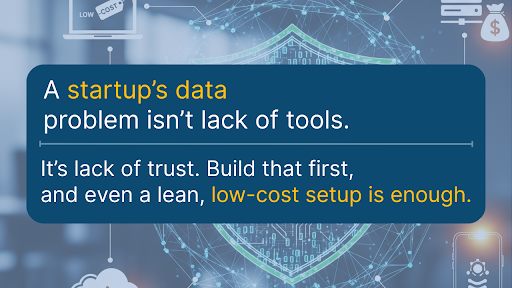
Business Intelligence requires resources that most startups don’t yet have.
But the truth is, you don’t need a six-figure data warehouse or a fancy analytics suite to start building a culture where decisions lean on numbers, not gut alone. If you are willing to prioritise clarity over frills, you can run solid business intelligence at a fraction of the expected cost.
- Here’s how to build a lean, functional data stack in a start-up environment and why it works better than shiny tools.
1. Start Simple, Then Layer
In my experience, your first “data stack” does not need to be a stack at all. A basic spreadsheet and a shared doc — or even Notion — is a good place to start. What matters early is consistency and discipline in how data is captured and used, not the sophistication of the tool.
As you grow, you can layer in what is truly needed — a dashboard here, an automated workflow there — always choosing wisely.
- Automate the repeatable work (reports, alerts, reconciliations).
- Keep space for manual exploration and contingent questions (because not everything can be templated).
The real advantage comes from building hybrid workflows that balance efficiency with flexibility.
2. Data-Ops Hygiene Is Non-Negotiable
Tools only matter if discipline follows. That is where culture begins.
- Single Source of Truth Folders – Decide where final data lives (e.g., S3, GDrive, or even structured folders). The key is to avoid scattered duplicates that create confusion.
- Quarterly Metric Sunset – Every 90 days, retire vanity metrics that no longer serve. If the metric doesn’t influence decisions, it is not for you anymore.
- Version-Control for Dashboards – Don’t let “dashboard sprawl” creep in. Archive or merge duplicates before they dilute attention.
It sounds boring, but this hygiene is what separates insight from chaos.
3. Runway Matters, So Start Early
Start-ups often wait too long. The irony is that the later you begin, the costlier it gets. Retrofitting clean data pipelines after scaling is painful.
Starting lean gives you two wins:
- Velocity – Teams can have numbers by Monday morning, not 3 weeks later.
- Trust – Because everyone knows the metrics are current, sourced from one place, and reviewed together.
That trust becomes the culture. People stopped debating whose numbers are “right” and started asking the real questions: What do we do next?
4. Vanity vs. Value
Metrics are never neutral. They only tell the story you want them to. That is why you need to sunset metrics quarterly.
If a metric doesn’t drive growth or retention, it’s just noise.
And if page views are not leading to more signups, they don’t add real value. If engagement minutes are not improving retention, they are meaningless.
The discipline of pruning vanity metrics keeps teams focused on outcomes that matter to survival.
5. The Payoff
Running a lean ₹15,000-a-month stack isn’t glamorous. But it can deliver something more valuable than dashboards: a culture where data drives debate, not decorates slides.
And that is the real ROI when numbers stop being a chore and start being the language of how you grow.
Closing Thought
Being “data-driven” isn’t about having the best tools. It’s about enforcing clarity, trust, and discipline with the tools you can afford. The stack just makes it easier.
Most start-ups think they will “do data later.” But the later you start, the harder it gets. Which part of this approach would make the biggest difference in how your team works today?
#DataDriven #StartupGrowth #BusinessIntelligence #LeanOps #DecisionMaking


